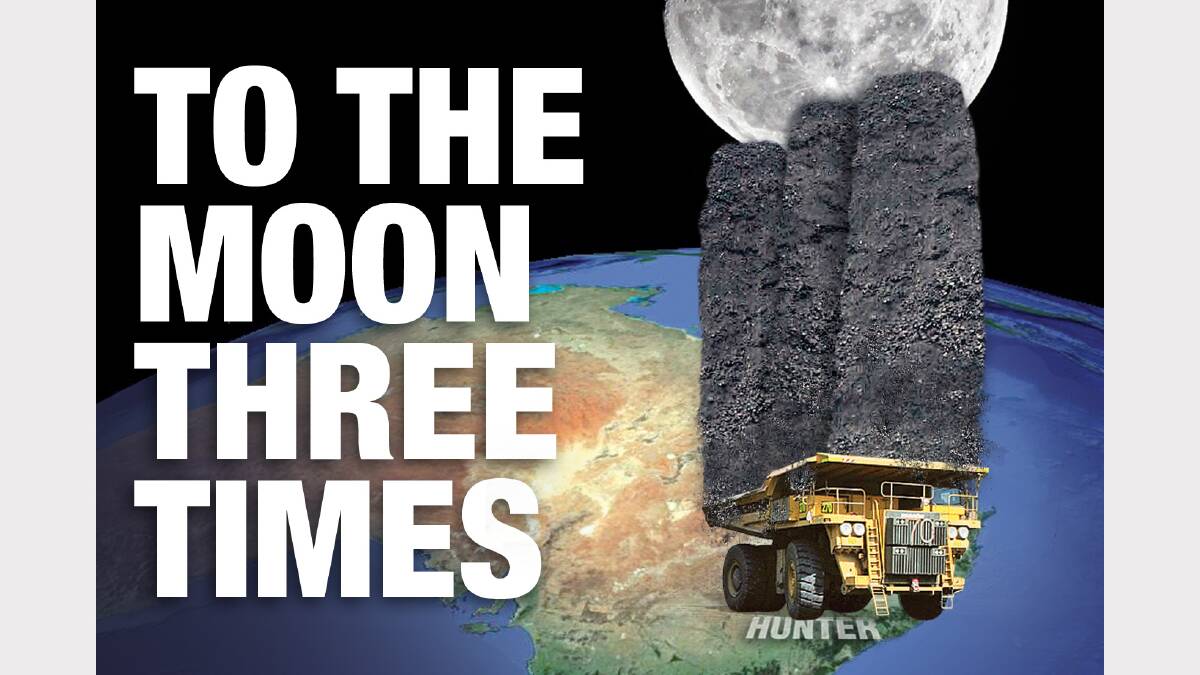
Subscribe now for unlimited access.
or signup to continue reading
MORE than 1.5billion tonnes of coal – enough to create three metre-square columns stretching between the Earth and the moon – have been extracted from the Hunter Valley over the past 14 years.
A series of aerial photos taken recently by the Newcastle Herald show exactly where the multibillion-dollar bonanza originates.
Open-cut coalmines spanning several kilometres wide and reaching hundreds of metres deep have been gouged into the Hunter landscape where rural communities once lived and the agricultural industry thrived.
The Herald this week revisits its 2005 “King Coal” series of articles that analysed the social, economic and environmental impacts of the mining boom.
THE coal industry’s economic value to the Hunter and NSW is undeniable.
It has attracted hundreds of millions of dollars in foreign investment, created thousands of jobs and reaped the state government billions of dollars in revenue.
New calculations by University of Newcastle’s School of Mathematical and Physical Sciences head John O’Connor show that if you took all the coal produced in the Hunter Valley in the past 14 years, you could build a metre-square column to the moon three times. That amount of coal could also wrap around the Earth’s equator 28.8 times, fill Sydney Harbour twice or fill 460,000 Olympic-sized swimming pools.
And there’s more to come.
Rio Tinto’s Carrington West extension, its proposed Warkworth expansion and Anglo American’s proposed Drayton South pit will significantly expand the industry’s footprint in the region.
The NSW Minerals Council estimates the number of direct Hunter mining jobs has almost doubled in the past decade to more than 12,000.
“The expansion of mining during the last decade has also led to significant commercial, residential and industrial development and generated economic activity for thousands of local Hunter businesses,” Minerals Council chief executive Stephen Galilee said.
“Hunter mining operations now spend around $6.3billion in the Hunter, contributing to around 60,000 local Hunter jobs. The total impact of this spending and employment is estimated to deliver to around one-third of the gross regional product of the Hunter Region.” Despite that, government regulation and planning policies have failed to protect those living in communities, such as Bulga and Camberwell, beside open-cut mines. For them, the past decade has been about living with the effects of declining air quality and increasing noise and blast shocks.
And the mines are pushing closer towards their homes and into areas previously off-limits to mining.
‘‘Since the day Ashton Coal landed on our doorsteps, and as more mines encroached on our village, the term ‘cumulative’ has been disguised by ‘mitigation’, which provides no protection for residents but is a safety net for the mining industry to inflict harm with approval from our government,’’ Camberwell resident Deidre Olofsson said.
‘‘We have been dictated to by a industry that has the right to make noise that keeps you awake all night and which owns and regulates its own equipment.
‘‘They hide behind legislation that is written [more] for them than for the protection of innocent families who want to go on with a normal peaceful life.’’
There’s also the incalculable loss of prime agricultural land and associated aquifers.
University of Sydney anthropologists Linda Connor and Phil McManus estimate that mining occupies 16per cent of the Upper Hunter valley floor.
The NSW Minerals Council disputes this and puts the figure at about 0.7per cent.
“The future after this massive extraction will be felt by my grandchildren, that’s when the costs will come,” Ms Olofsson said.
But Singleton mayor John Martin is more optimistic.
He argues that the needs of industry and environment can be balanced.
“Going back 30 or 40 years, we needed industry and it happened to be the coal industry and that’s progressed through to what it is today.
‘‘Singleton would not be the town and area that it is except for the coal industry and the associated industries that go with it,” he said.
“It’s well known when you dig a hole it doesn’t look real good.
‘‘But if you are going to have a vegetable garden, you have got to dig it up before the plants will grow.
Coal exports through the Port of Newcastle (mass tonnes)
■ 2004 77.7million
■ 2005 80.6million
■ 2006 79.6million
■ 2007 84.6million
■ 2008 91.7million
■ 2009 92.7million
■ 2010 102.6million
■ 2011 114.2million
■ 2012 134.2million
■ 2013 150.5million
Source: Newcastle Port Corp
BY IAN KIRKWOOD
WHITEHAVEN Coal’s environmental policies at Maules Creek go under the microscope today when a Senate committee into environmental offsets holds a public hearing in Sydney.
Maules Creek is one of five projects being examined by the inquiry, which is looking at the ‘‘history, appropriateness and effectiveness’’ of environmental offsets in Australia.
Offsets are where land in one place is preserved to balance or counter the environmental impact of a project in another.
The federal inquiry is holding today’s hearings in State Parliament, in Sydney, with Lock the Gate Alliance policy officer Georgina Woods listed as the first speaker.
Another seven speakers are scheduled today including Central West Environment Council secretary Bev Smiles and representatives of Lake Macquarie City Council, Greenpeace Australia and the Environmental Defenders Office (Victoria).
Ms Woods said yesterday that the offset system was being abused by mining companies and offered little or no protection to critically endangered ecological communities.
In its submission, Lake council said offsets ‘‘are an important tool for slowing the decline in biodiversity’’ but it warned they should not be used when a development ‘‘removes or adversely impacts’’ an ecosystem that ‘‘cannot be replaced’’.

